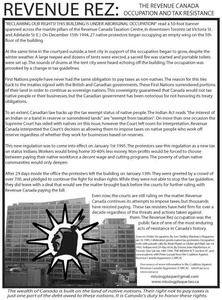Public domain text of the Revenue Rez poster from The Missing Plaque Project...
REVENUE REZ:
 Revenue Rez poster from The Missing Plaque Project. THE REVENUE CANADA OCCUPATION AND TAX RESISTANCE
Revenue Rez poster from The Missing Plaque Project. THE REVENUE CANADA OCCUPATION AND TAX RESISTANCE
“RECLAIMING OUR RIGHTS! THIS BUILDING IS UNDER ABORIGINAL OCCUPATION!” read a 50-foot banner spanned across the marble pillars of the Revenue Canada Taxation Centre, in downtown Toronto (at Victoria St. and Adelaide St. E.). On December 15th 1994, 27 native protestors began occupying an empty wing on the 5th floor of the building.
At the same time in the courtyard outside, a tent city in support of the occupation began to grow, despite the winter weather. A large teepee and dozens of tents were erected, a sacred fire was started and portable toilets were set up. The sounds of drums at the tent city were heard echoing off the building. The occupation was provoked by a change in tax guidelines.
First Nations people have never had the same obligation to pay taxes as non-natives. The reason for this ties back to the treaties signed with the British and Canadian governments. These First Nations surrendered portions of their land in order to continue as sovereign nations. This sovereignty guaranteed that Canada would not tax native people or their businesses, but the Canadian government has been notorious for not honoring its treaty obligations.
To an extent, Canadian law backs up the tax exempt status of native people. The ['Indian Act"] reads “the interest of an Indian or a band in reserve or surrendered lands” are “exempt from taxation”. On more than one occasion the Supreme Court has sided with natives on this issue, however the Court left room for interpretation. Revenue Canada interpreted the Court’s decision as allowing them to impose taxes on native people who work off reserve regardless of whether they work for businesses based on reserves.
This new regulation was to come into effect on January 1st 1995. The protestors saw this regulation as a new tax on status Indians. Workers would bring home 30-40% less money. Non-profits would be forced to choose between paying their native workforce a decent wage and cutting programs. The poverty of urban native communities would only deepen.
After 29 days inside the office the protesters left the building on January 13th. They were greeted by a crowd of over 700, and pledged to continue the fight for Indian rights. While they were not able to stop the tax guideline, they did leave with a deal that would see the matter brought back before the courts for further ruling, with Revenue Canada paying the bill.
Even now, the courts are still ruling on the matter. Revenue Canada continues its attempts to impose taxes, but thousands have resisted paying. These tax resisters have held firm for over a decade regardless of the threats and actions taken against them. The Revenue Rez occupation was the public face of one of the most enduring acts of resistance in Canada’s history.
The wealth of Canada is built on the land of native nations. Their right not to pay taxes is just one part of the debt owed to these nations. It is Canada’s duty to honour these rights.
Sources:
- Under Occupation, By Joe Chidley, Maclean’s Magazine, jan 16 1995,
- Celebration greets native tax protesters Occupation ends with parade, rally, By Rudy Platiel, in Globe and Mail, Jan 14, 1995,
- Indians end 29-day sit-In, By Donna Jean MacKinnon, in Toronto Star Sat Jan 14th 1995,
- THE INDIAN ACT, Section 87, and conversations with Peter Luczak from the Coalition Against Revenue Canada Aggression (CARCA)
- One source of more information is the Coalition Against Revenue Canada Aggression (CARCA): [email protected] http://www.carca.ca


